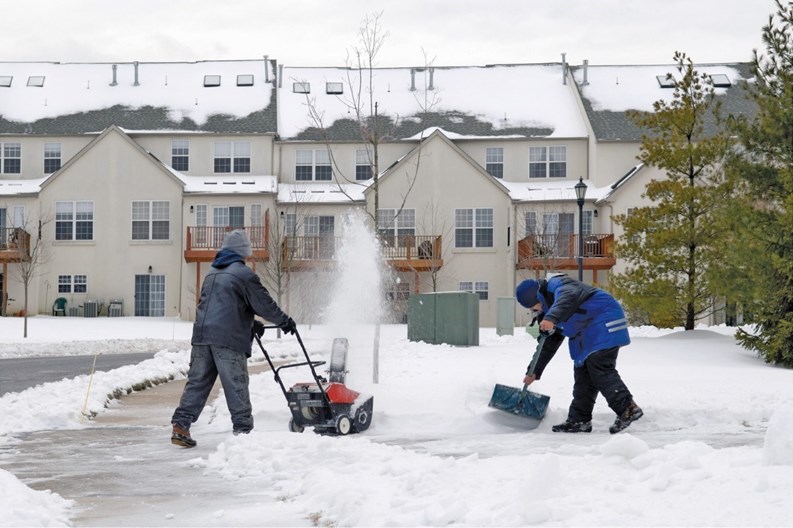With the arrival of the snowfall season in New England, most community associations are hurriedly pulling out their snow blowers and double checking their plowing contracts. At a few condominiums, however, the arrival of winter is being greeted with a little less urgency.
These condominiums are part of a growing number using heated pavement, where electrical wires or hot piping underneath the sidewalks or driveways turn falling snowflakes into harmless water.
Heated pavement is expensive to install and operate, but it has a number of advantages over plowing, especially for communities with special circumstances.
Properties with a small footprint and little open space to dump snow -- typically mid- or high-rises in downtown areas – don’t have to struggle to find places to store excess snow.
Growing numbers of condominiums are in municipalities that restrict salt or salt-substitutes, out of concern over ground water contamination. Condos with heated pavements contribute nothing but pure melted snow (water) to the local aquifer.
Other properties have sloping driveways that either enter into a garage or empty out unto a public street. If ice builds up on these inclines, cars can skid into garage doors or gates, or slide into oncoming traffic.
Condos with undersized parking lots can skip playing “musical chairs” with owners’ cars to make room for plows during a nor’easter.
Some properties are concerned about slip-and-falls occurring in pedestrian paths – especially those in 55-and-over communities. Heated pavement can greatly reduce accidents and their accompanying legal exposure.
Finally, heated pavement helps curtail or eliminate the use of deicers, many of which can wreak havoc on concrete (see sidebar).
Limiting Costs
One strategy for limiting expenses is to install heated pavement only in key areas – like inclined driveways or in most-used pedestrian pathways. Heated pavement can run between $10 and $15 dollars per square foot to install and about 25 cents per square foot each month to operate, depending on the severity of the winter. But curtailing the installation to problem areas only is seen by some condominiums as a good return on investment.
Two Types of Heated Pavement
There are two types of heated pavement, hydronic and electric radiant. Electric radiant employs low-voltage mats installed under driveways or pavement, which are heated using electricity. Hydronic employs small tubing running underneath the pavement, in which heated water mixed with anti-freeze is circulated. A hydronic system requires a heat source, typically a small boiler.
Hydronic systems are a great fit for large community associations that have an on-site physical plant that generates steam for heat, says Bob Rullie, owner of Rullie Plumbing & Radiant Heating in Westborough, Massachusetts.
Steam that is returning to the boiler as hot water after heating units can provide energy for a hydronic system at almost no additional cost.
"The energy is almost free, because they heat the building with steam and the byproduct (heat) is what we use,” says Rullie.
Installation of a hydronic system starts with excavation of the driveway or pavement, followed by the installation of a gravel bed, into which a layer of insulation (insultarp) is added. The insulation is important, says Rullie, because “you want to direct the heat toward the finish material (pavement) so you can melt the snow.”
PEX (cross-linked polyethylene) tubing is laid on top of the insulation and tied down with reinforced wire, and asphalt or pavers are laid directly on top of the tubing.
When installing heated pavement, it’s important to provide a pathway for the melted snow to be directed away from the building and places where owners walk, he says. “Once that water gets to where there’s no snow melt, you get a real big ice dam,” he says.
The installation of an electric system is quite similar to a hydronic system, but mats containing electric coils are installed instead of piping, says Michele Pondi Salik, president of DaVinci Pavement Design in Stratford, Connecticut.
The electric coils inside the mats areattached to an electrical sub-panel or junction box, and the system is pretty much ready to go.
To contain costs, some properties install heated mats only in heavily-traveled pedestrian areas or in two-foot-wide strips spaced to coincide with tire tracks. This allows traction on hilly areas and saves on costs all around.
There are two ways of triggering the heated pavement, either by a simple on/off switch or by a sophisticated sensor. With the on/off switch, the property manager turns it about 10 to 12 hours before a storm – the amount of time it takes to get the pavement hot enough to melt snow. If the pavement is not heated up well in advance, snow can build up and thwart the system.
Also available is a sophisticated sensor, which is more like a “mini weather station,” says Salik. The sensor – which costs about $1,800 – takes continuous temperature and humidity readings and automatically turns the heater on hours before a storm and shuts it down afterwards.
Rullie looks forward to the day when solar panels can be used to power heated pavement, something currently being researched. In the meantime, heated pavement is expensive but is proving quite useful to many condominiums.
Jim Douglass is the managing editor of New England Condominium magazine.







2 Comments
Leave a Comment